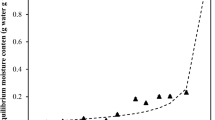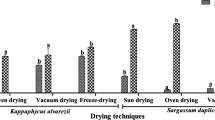Abstract
The effect of different drying techniques on the phytochemical content and antioxidant activity of Kappaphycus alvarezii (‘crocodile’ morphotype) were investigated. Phytochemical (total phenolic, flavonoid, anthocyanin and carotenoid content) and antioxidant activity of the seaweed were determined. The seaweed was dried using seven types of drying techniques; oven drying (temperature of 40 °C), oven drying (temperature of 80 °C), sun drying, hang drying, sauna drying, shade drying and freeze drying. There were significant differences in the phytochemical content and antioxidant activity between the dried seaweed samples. The total phenolic content of the dried samples were in the range of 26.11 to 53.33 mg gallic acid equivalent (GAE) per 100 g, total flavonoid content from 9.83 to 25.67 mg catechin equivalent (CE) per 100 g, total anthocyanin content from 0.05 to 0.11 mg cyanidin-3-glucoside equivalent (C-3-GE) per gramme and total carotenoid content from 0.03 to 0.24 mg β-carotene equivalent (BCE) per gram, respectively. The oven-dried (40 and 80 °C) and shade-dried samples contained the highest values of phytochemical content as compared to other dried samples tested. Antioxidant activity were determined using 2,2-diphenyl-1-picrylhydrazyl (DPPH), 2,2-azino-bis-(3-ethyl-benzothiazoline-6-sulphonic acid) (ABTS) and ferric reducing/antioxidant power (FRAP) assays. The oven-dried (40 and 80 °C) and shade-dried samples also displayed stronger scavenging activity and reducing ability as compared to other dried samples tested. The lower values of phytochemical content and weak antioxidant activity were detected in sun-dried and sauna-dried samples. This finding suggested that different drying techniques greatly influence the occurrence of phytochemical content and antioxidant activity in seaweeds.

Similar content being viewed by others
References
Amarowicz R, Carle R, Dongowski G, Durazzo A, Galensa R, Kammerer D, Maiani G, Piskula MK (2009) Influence of postharvest processing and storage on the content of phenolic acids and flavonoids in foods. Mol Nutr Food Res 53:S151–S183
Benzie IF, Strain JJ (1996) The ferric reducing ability of plasma (FRAP) as a measure of “antioxidant power”: the FRAP assay. Anal Biochem 239:70–76
Burritt DJ, Larkindale J, Hurd CL (2002) Antioxidant metabolism in the intertidal red seaweed Stictosiphonia arbuscula following desiccation. Planta 215:829–838
Carrillo S, Castro MI, Perez-gil F, Rosales E, Manzano RE (1992) The seaweed (Sargassum sinicola Setchel & Gardner) as an alternative for animal feeding. Agric Sci 26:177–181
Chan JCC, Cheung PCK Jr, POA (1997) Comparative studies on the effect of three drying methods on the nutritional composition of seaweed Sargassum hemiphyllum (Turn.) C. Ag. J Agric Food Chem 45:3056–3059
Chatterji A, Dhargalkar VK, Sreekumar PK, Parameswaran PS, Rodrigues R, Kotnala S (2004) Anti-influenza activity in the Indian seaweeds—a preliminary investigation. National Institute of Oceanography, Goa
Dixon RA, Paiva NL (1995) Stress-induced phenylpropanoid metabolism. Plant Cell 7:1085–1097
FAO (1976) Production, trade and utilization of seaweeds and seaweed products. In FAO Fisheries Technical Paper No. 159; Food and Agriculture Organization of the United Nations: Rome 8
Garau MC, Simal S, Rosselló C, Femenia A (2007) Effect of air-drying temperature on physico-chemical properties of dietary fibre and antioxidant capacity of orange (Citrus aurantium v. canoneta) by-products. Food Chem 104:1014–1024
Giusti MM, Wrolstad RE (2001) Characterization and measurement of anthocyanins by UV-visible spectroscopy. In: Wrolstad RE (ed) Current protocols in food analytical chemistry. Wiley, NY, pp 1–13
Gupta S, Cox S, Abu-Ghannam N (2011) Effect of different drying temperatures on the moisture and phytochemical constituents of edible Irish brown seaweed. LWT Food Sci Technol 1–7
Hamdy AEA, Dawes CJ (1988) Proximate constituents and lipid chemistry in two species of Sargassum from the west coast of Florida. Bot Mar 31:79–81
Hammed AM, Asiyanbi-Hammed TT, Jaswir I, Amid A, Alam MZ (2013) Effects of drying methods on nitric oxide inhibition potential of water soluble extracts of Turbinaria turbinata: a brown seaweed species of Malaysian origin. Am J Drug Discov Dev 3:279–285
Hess D, Keller HE, Oberlin B, Bonfanti R, Schuep W (1991) Simultaneous determination of retinol, tocopherols, carotenes and lycopene in plasma by means of high performance liquid chromatography on reversed phase. Vitam Nutr Res 61:232–238
Hurtado AQ, Gerung GS, Yasir S, Critchley AT (2014) Cultivation of tropical red seaweeds in the BIMP-EAGA region. J Appl Phycol 26:707–718
Ismail A, Tan SH (2002) Antioxidant of selected commercial seaweeds. Malays J Nutr 8(2):167–177
Jiménez-Escrig A, Jiménez- Jiménez I, Pulido R, Saura-Calixto F (2001) Antioxidant activity of fresh and processed edible seaweeds. J Sci Food Agric 81:530–534
Klein BP, Kurilich AC (2000) Processing effects of dietary antioxidants from plant food. Hortscience 35:580–584
Kuda T, Tsunekawa M, Goto H, Araki Y (2005) Antioxidant properties of four edible algae harvested in the Noto Peninsula, Japan. J Food Compos Anal 18:625–633
Kumar SK, Ganesan K, Subba Rao PV (2008) Antioxidant potential of solvent extracts of Kappaphycus alvarezii (Doty) Doty—an edible seaweed. Food Chem 107:289–295
Li BB, Smith B, Hossain MM (2006) Extraction of phenolics from citrus peels: I. Solvent extraction method. Sep Purif Technol 48:182–188
Mabeau S, Fleurence J (1995) Seaweeds in food products: biochemical and nutritional aspects. Trends Food Sci Technol 6:103–107
Mabeau S, Cavaloc E, Fleurence J, Lahaye M (1992) New seaweed based ingredients for the food industry. Int Food Ingred 3:38–45
Martins CDL, Ramlov F, Nocchi Carneiro NP, Gestinari LM, dos Santos BF, Bento LM, Lhullier C, Gouvea L, Bastos E, Horta PA, Soares AR (2013) Antioxidant properties and total phenolic contents of some tropical seaweeds of the Brazilian coast. J Appl Phycol 25:1179–1187
Matanjun P, Mohamed S, Mustapha NM, Muhammad K, Ming CH (2008) Antioxidant activities and phenolics content of eight species of seaweeds from north Borneo. J Appl Phycol 20:367–373
Mensor LI, Menezes FS, Leitao GG, Reis AS, Dos Santos T, Coube CS, Leitao SG (2001) Screening of Brazillian plant extracts for antioxidant activity by the use of DPPH free radical method. Phytother Res 15:127–130
Mishra VKF, Temelli PF, Shacklock O, Craigie JS (1993) Lipids of the red alga Palmaria palmata. Bot Mar 36:169–174
Msuya FE, Buriyo A, Omar I, Pascal B, Narrain K, Ravina JJM, Mrabu E, Wakibia JG (2014) Cultivation and utilisation of red seaweeds in the Western Indian Ocean (WIO) Region. J Appl Phycol 26:699–705
Murphy C, Hotchkiss S, Worthington J, McKeown S (2014) The potential of seaweed as a source of drugs for use in cancer chemotherapy. J Appl Phycol 26:2211–2264
Ponmari G, Sathishkumar R, Lakshmi PTV (2011) Effect of drying treatment on the contents of antioxidants in Cardiospermum halicacabum Linn. J Pharm Biosci 2:304–313
Prud’homme van Reine WF, Toron GC Jr (2001) Plant resources of south-east Asia 15(1) Cryptogams. Algae. Backhuys Publishers, Leiden, 318
Ragan MA, Glombitza KW (1986) Phlorotannins, brown algal polyphenols. Prog Phycol Res 4:129–241
Re R, Pellegrini N, Proteggente A, Pannala A, Yang M, Rice-Evans C (1999) Antioxidant activity applying an improved ABTS radical cation decolorisation assay. Free Radic Biol Med 26:231–237
Sabeena KHF, Jacobsen C (2013) Phenolic compounds and antioxidant activities of selected species of seaweeds from Danish coast. Food Chem 138:1670–1681
Tan J, Lim P-E, Phang S-M (2013) Phylogenetic relationship of Kappaphycus Doty and Eucheuma J. Agardh (Solieriaceae, Rhodophyta) in Malaysia. J Appl Phycol 25:13–29
Tomaino A, Cimino F, Zimbalatti V, Venuti V, Sulfaro V, Pasquale A, Saija A (2004) Influence of heating on antioxidant activity and the chemical composition of some spice essential oils. Food Chem 89:549–554
Valdebenito H, Bittner M, Sammes PG, Silva M, Watson WH (1982) A compound with antimicrobial activity isolated from the red seaweed Laurencia chilensis. Phytochem 21:1456–1457
Velioglu YS, Mazza G, Gao L, Oomah BD (1998) Antioxidant activity and total phenolics in selected fruits, vegetables and grain products. J Agric Food Chem 46:4113–4117
Wong K, Cheung PC (2001) Influence of drying treatment on three Sargassum species 2. Protein extractability, in vitro protein digestibility and amino acid profile of protein concentrates. J Appl Phycol 13:51–58
Wong CK, Ooi VEC, Ang P (2000) Protective effects of seaweeds against liver injury caused by carbon tetrachloride in rats. Chemosphere 41:173–176
Yuan YV, Walsh NA (2006) Antioxidant and antiproliferative activities of extracts from a variety of edible seaweeds. Food Chem Toxicol 44:1144–1150
Yuan H, Zhang W, Li X, Li N, GaO X (2005) preparation and in vitro antioxidant activity of ĸ-carrageenan oligosaccharides and their oversulfated, acetylated and phosphorylated derivatives. Carbohydr Res 340:685–692
Zhishen J, Mengcheng T, Jianming W (1999) The determination of flavonoid contents in mulberry and their scavenging effects on superoxide radicals. Food Chem 64:555–559
Acknowledgments
The authors would like to acknowledge Institute for Tropical Biology and Conservation and Seaweed Research Unit, Universiti Malaysia Sabah, Malaysia, for the use of the laboratory facilities and technical assistance.
Author information
Authors and Affiliations
Corresponding author
Rights and permissions
About this article
Cite this article
Ling, A.L.M., Yasir, S., Matanjun, P. et al. Effect of different drying techniques on the phytochemical content and antioxidant activity of Kappaphycus alvarezii . J Appl Phycol 27, 1717–1723 (2015). https://doi.org/10.1007/s10811-014-0467-3
Received:
Revised:
Accepted:
Published:
Issue Date:
DOI: https://doi.org/10.1007/s10811-014-0467-3




